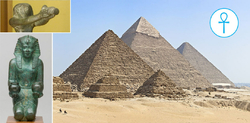- Retour accueil
- Vous êtes ici : Blog The Pyramids of the Cold The Pyramids of the Cold Section 26 • The Tree of Life caisson and the Smiter nobody can see
The Pyramids of the Cold Section 26 • The Tree of Life caisson and the Smiter nobody can see
Publié par Bruno Coursol dans The Pyramids of the Cold le 10/10/2022 à 17:15
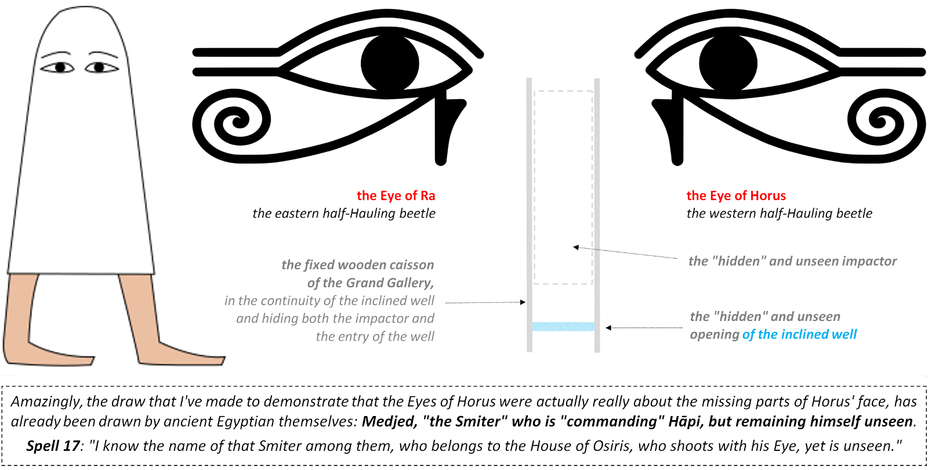
Medjed is an ancient Egyptian god mentioned in the Book of the Dead, who is described as the "Smiter" (le "Cogneur", le "Frappeur"). Because of his ghost-like portrayal in some illustrations on the Greenfield papyrus (without any mouth or nose), Medjed has earned great popularity in modern Japanese culture, including as a character in video games and anime. Medjed is "invisible" and can't be seen, though belonging to the "House of Osiris". Draw of Medjed by Di (they-them) at https://commons.wikimedia.org/wiki/File:Medjed.svg
The Pyramids of the Cold Section 26: the sacred Tree of Life wooden caisson and the Smiter nobody can see
In summary: I didn't really think I would be able to find any evidence supporting the idea discussed in previous Sections 24 and 25, that the Eyes of Horus are actually all about the missing parts of Horus' face. If the nose and the mouth of Horus are missing, it is only because they are metaphorical representations of the impactor and the opening of the inclined well of the Great Pyramid of Giza. More importantly if these elements are both missing, it is because they were completely hidden inside the wooden fixed caisson of the Grand Gallery, when the Great Pyramid was in operation.
When the act of towing was performed in the Grand Gallery, or when the impactor was released into the slope so that it could ram into the inclined well waters, no one could have seen them: the impactor and the "mouth" of the well were invisible.
But I was wrong: ancient Egyptians really did represent the exact same face, showing only the eyes, and with the nose and the mouth missing. They represented this in a late and very obscure deity, named Medjed, described as "the Smiter", an ancient Egyptian god commanding Hapi, hence the waters from the Nile, and who belonged to "the House of Osiris". Medjed was also "invisible": he couldn't be seen by anybody.
In other words, Medjed is a perfect representation of what I've been describing in this study: the operation of an impactor that would have been completely invisible when ramming into waters originating in the Nile river, because moving inside a wooden fixed caisson. An impactor which would have had all its ramming power nested into the Osiris granite stone.
Medjed is a representation of the impactor; another one, just like the Apis bull or Horus the elder, but this time it is not just about the force and energy of the bull, nor it is about the speed of a flying falcon: this time, Medjed is all about the impact itself and the fact that he, as the deification of the impactor of the Great Pyramid couldn't be seen.
In this Section, we'll learn more about the fixed caisson, and in particular that it had been deified like everything else related to the operation of the Great Pyramid: the caisson of the Grand Gallery is the Tree of Life. This is why Isis, who is the deification of the impactor's Hauling rope (the One who is "saving" Osiris, the central rope), is known to be the goddess of the Acacia Tree of Life: because, when Isis and the impactor were connected to each other during the Hauling process, they were both moving inside the caisson.
Isis is the Lady of the Acacia Tree of Life because as a rope, she was relentlessly moving inside the wooden caisson of the Grand Gallery.
Talking about trees, we'll also see some representations that have been made of the Sarcophagus of the Great Pyramid, when it was operated as a biosand "earth" filter for water softening and microbial treatment that was necessary to reduce salt encrustations during the evaporative cooling process. The palm Trees in the famous "drinking water" and "kissing the earth" scenes in the tombs of Irynefer and Pashedu, are metaphoric representations of the operating of the Sarcophagus that produced drinking water at a very slow rate, just like the palm tree does.
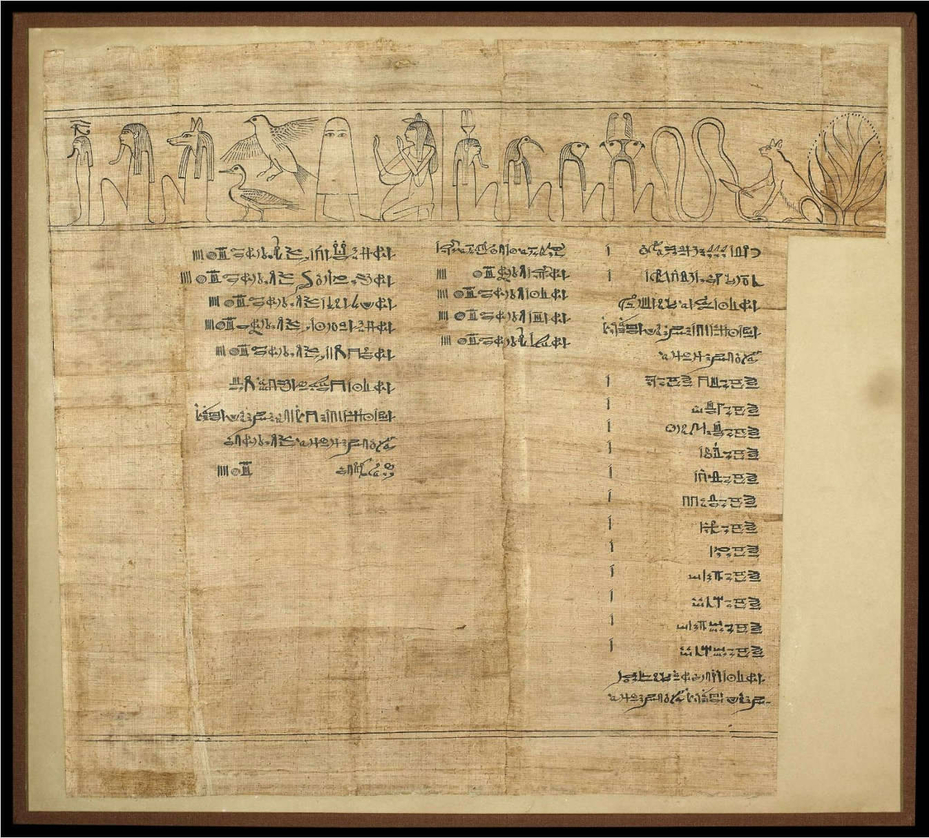
Sheet 76 of the Book of the Dead of Nestanebetisheru, known as the "Greenfield Papyrus". 950 BCE to 930 BCE, 21st or 22nd Dynasty. Picture courtesy of the British Museum, but not available as of today: https://www.britishmuseum.org/collection/object/Y_EA10554-76
26.01 Medjed is the "Smiter": the ancient Egyptian version of what I've been calling the "impactor"
We've seen in previous Sections that the impactor has been deified in many very different representations, each one of them focusing on one or some of its particular aspects (Sections 23 and 24):
• The hawk or falcon (Horus) is about the speed acquired during the descent
• The Apis bull is about the force and the water projections both frontwards and backwards
• The ram's horns are about the impact itself, the ramming
Medjed, as the "Smiter" is also evidently about the ramming but with the "invisible" and "unseen" touch that is due to the central fixed wooden caisson. We'll see further in this Section that this wooden caisson had been deified into the Tree of Life, and that if Isis is represented many times inside the Tree, visible or "invisible", it is because Isis is the representation of the impactor's Hauling rope.
Just like Medjed, Isis was moving inside the fixed caisson; and just like Medjed, Isis could also have been invisible.
"Spell 17 of the Book of the Dead mentions, amongst many other obscure gods, one Medjed (meaning "The Smiter"), in the following line: "I know the name of that Smiter among them, who belongs to the House of Osiris, who shoots with his eye, yet is unseen." https://en.wikipedia.org/wiki/Medjed
"E.A. Wallis Budge translated the corresponding passage in the New Kingdom Papyri, known as the "Theban Recension of the Book of the Dead" as follows: I know the being Mātchet [Medjed] who is among them in the House of Osiris, shooting rays of light from [his] eye, but who himself is unseen. He goeth round about heaven robed in the flame of his mouth, commanding Hāpi, but remaining himself unseen." https://en.wikipedia.org/wiki/Medjed
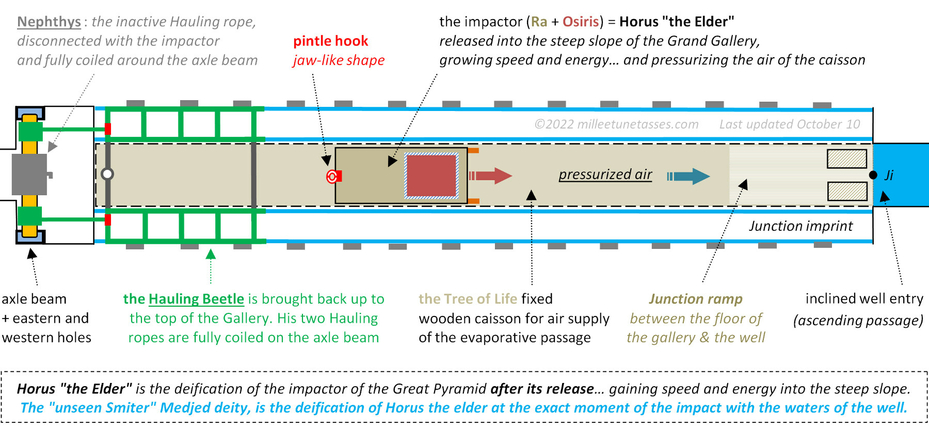
26.02 The "Smiter" Medjed impactor ramming into the waters of the well
During the entire process of Hauling, the impactor had been seen as Horus the child, just waiting to grow and release all the potential energy mostly nested into the Osiris stone. Horus the child becomes Horus the elder at the exact moment of its release: Horus "the Elder" is the deification of the impactor of the Great Pyramid gaining speed and energy into the steep slope of the Gallery.
In some ways, the "unseen Smiter" Medjed deity, could be described as the deification of Horus the elder at the exact moment of the impact with the waters of the well.
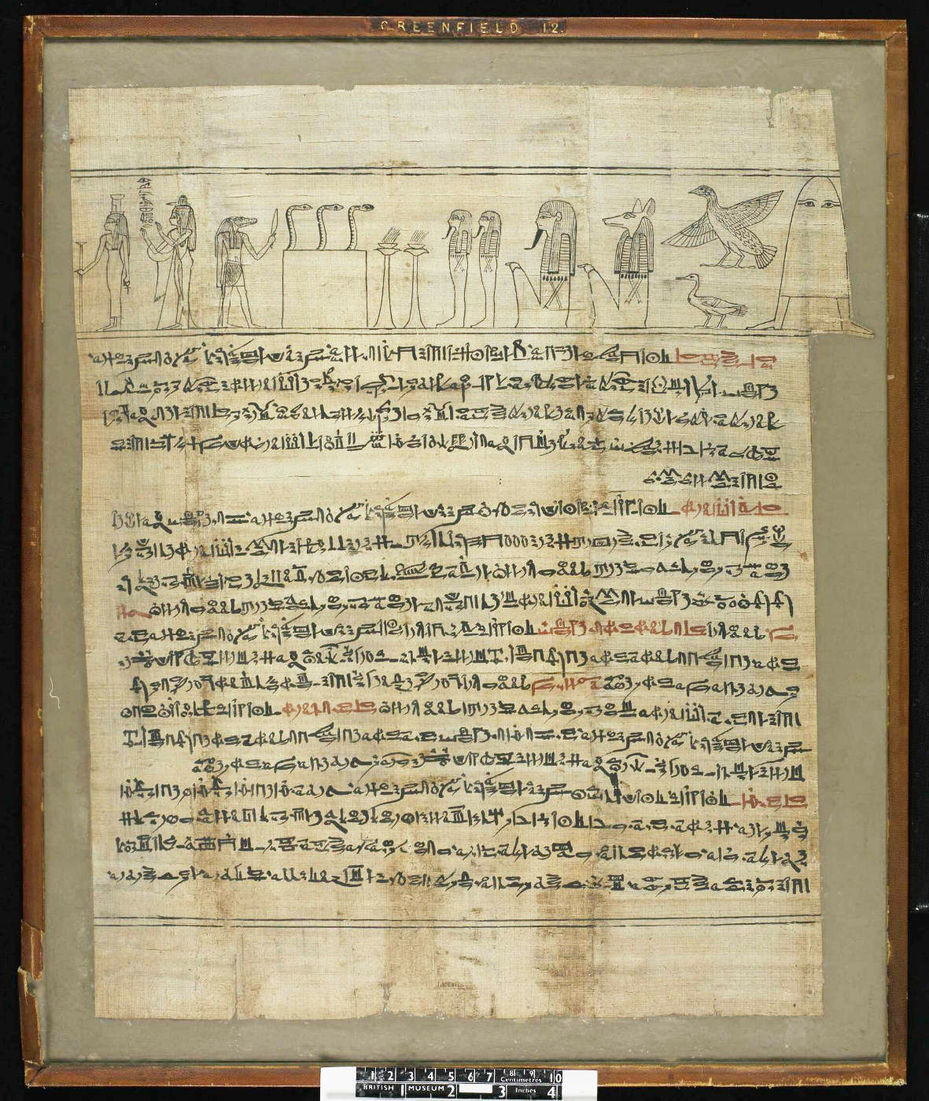
Sheet 12 of the Book of the Dead of Nestanebetisheru, known as the "Greenfield Papyrus". 950 BCE to 930 BCE, 21st or 22nd Dynasty. Picture courtesy of the British Museum (©Trustees of the British Museum): https://www.britishmuseum.org/collection/object/Y_EA10554-12
26.03 The Medjed deity in the Greenfield Papyrus
Following excerpts (adapted), are from "Medjed: from Ancient Egypt to Japanese Pop Culture", by Rodrigo B. Salvador (Staatliches Museum für Naturkunde Stuttgart. Stuttgart, Baden-Württemberg, Germany), a very interesting article on Medjed that I strongly recommend: https://jgeekstudies.org/2017/08/15/medjed-from-ancient-egypt-to-japanese-pop-culture/
"The main source of knowledge on Medjed is the so-called “Greenfield Papyrus”, where he appears twice. If the name of the papyrus seems a little awkward, that is because it is common for ancient Egyptian artifacts (especially papyri) to be named after the collector who owned it during the heyday of Egyptomania. In this case, this particular papyrus belonged to Mrs. Edith M. Greenfield, who donated it to the British Museum in 1910. The curator’s comments on the online collection of the British Museum summarizes it nicely:
“The ‘Greenfield Papyrus’ is one of the longest and most beautifully illustrated manuscripts of the ‘Book of the Dead’ to have survived. Originally, over thirty-seven metres in length, it is now cut into ninety-six separate sheets mounted between glass. It was made for a woman named Nestanebisheru, the daughter of the high priest of Amun Pinedjem II. As a member of the ruling elite at Thebes, she was provided with funerary equipment of very high quality. Many of the spells included on her papyrus are illustrated with small vignettes, and besides these there are several large illustrations depicting important scenes.” British Museum (2017)
The Greenfield Papyrus dates from the historical period known as New Kingdom, possibly from the end of the 21st Dynasty or the beginning of the 22nd, around 950–930 BCE (British Museum, 2017)."
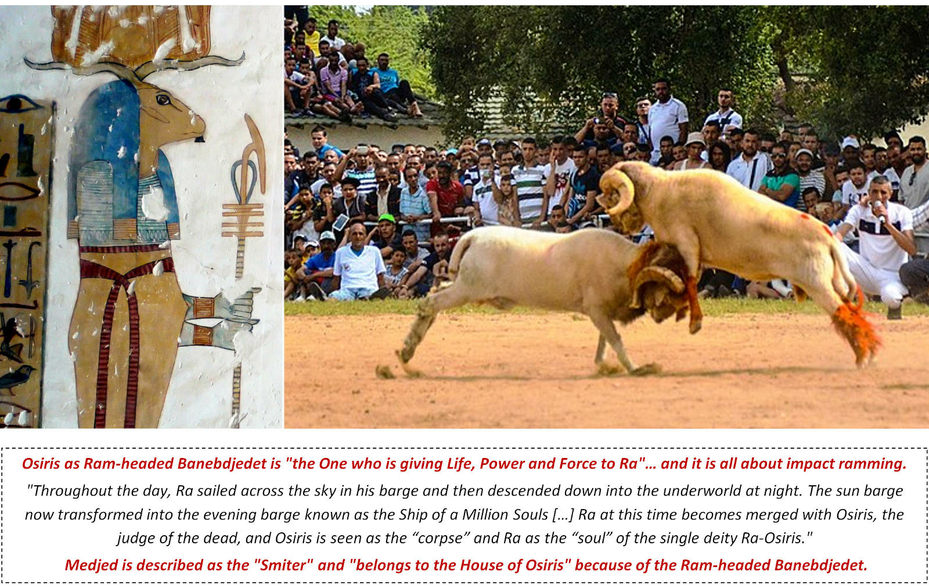
Banebdjedet wielding a scepter of the Was-sceptre, Djed, and Ankh. From the Tomb of Mentuherkhepeshef in the Valley of the Kings. Photograph thanks to kairoinfo4u: https://www.flickr.com/photos/manna4u/3331554556/in/photostream/
Ram fighting on Wikimedia Commons thanks to Brahim Djelloul Mustapha: https://commons.wikimedia.org/wiki/Category:Ram_fighting
26.04 Medjed the Smiter is having all his force because of Osiris as Ram-headed Banebdjedet
Osiris as Ram-headed Banebdjedet is "the One who is giving Life, Power and Force to Ra"… and it is all about impact ramming. "Throughout the day, Ra sailed across the sky in his barge and then descended down into the underworld at night. The sun barge now transformed into the evening barge known as the Ship of a Million Souls […] Ra at this time becomes merged with Osiris, the judge of the dead, and Osiris is seen as the “corpse” and Ra as the “soul” of the single deity Ra-Osiris."
Medjed is described as the "Smiter" and "belongs to the House of Osiris" because of the Ram-headed Banebdjedet.
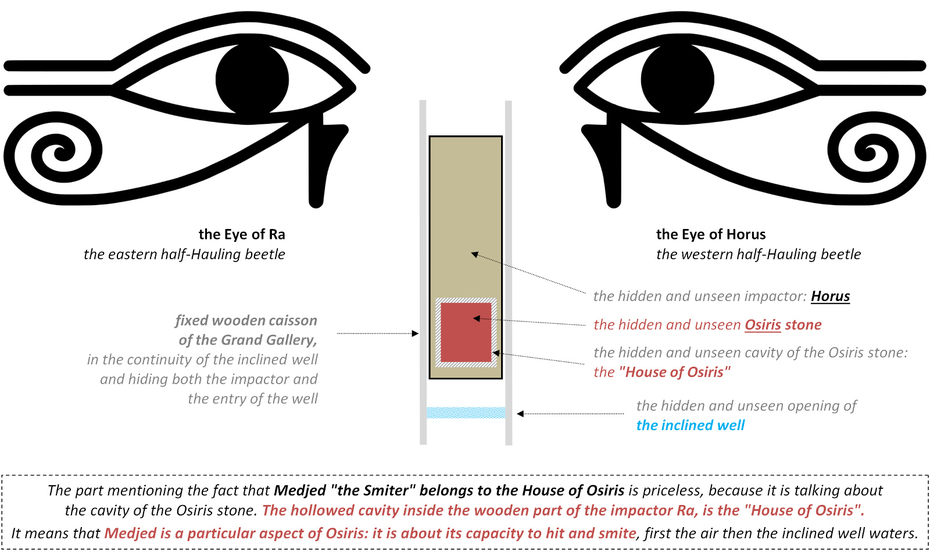
26.05 Medjed's "House of Osiris" is the hollowed out cavity of the wooden impactor to accommodate the Osiris stone
The part mentioning the fact that Medjed "the Smiter" belongs to the House of Osiris is priceless, because it is talking about the cavity in which is perfectly nested the Osiris stone.
The House of Osiris, is actually not a very difficult metaphor to decipher, because it is simply referring to the location where is standing Osiris; and we already know that Osiris, as the Osiris granite stone, was perfectly nested inside the wooden part of the impactor. Most probably the lower end of the wooden cradle had been hollowed out so that the granite stone would perfectly fit in.
It means that this hollowed out cavity inside the wooden part of the impactor, which is Ra, is the "House of Osiris".
It also means that Medjed is a particular aspect of Osiris: it is about its capacity to hit and smite, first the air then the inclined well waters. Medjed is taking all his smiting force and energy into the Osiris stone.
26.06 The linen mummy bandages origin in the Osiris stone protection wrappings
I've already mentioned the fact that the linen mummy wrappings or bandages, were originating in this particular assembly of the granite stone with the wooden cradle.
I didn't take into consideration the fact that the impactor was endlessly immerged into water, and that consequently the interior of the wooden cradle would have been exposed to constant humidity; it would have obliged to completely wrap the Osiris stone into thick layers of linen, just so it didn't move and damage the hollowed out cavity. Wet granite is very slippery.
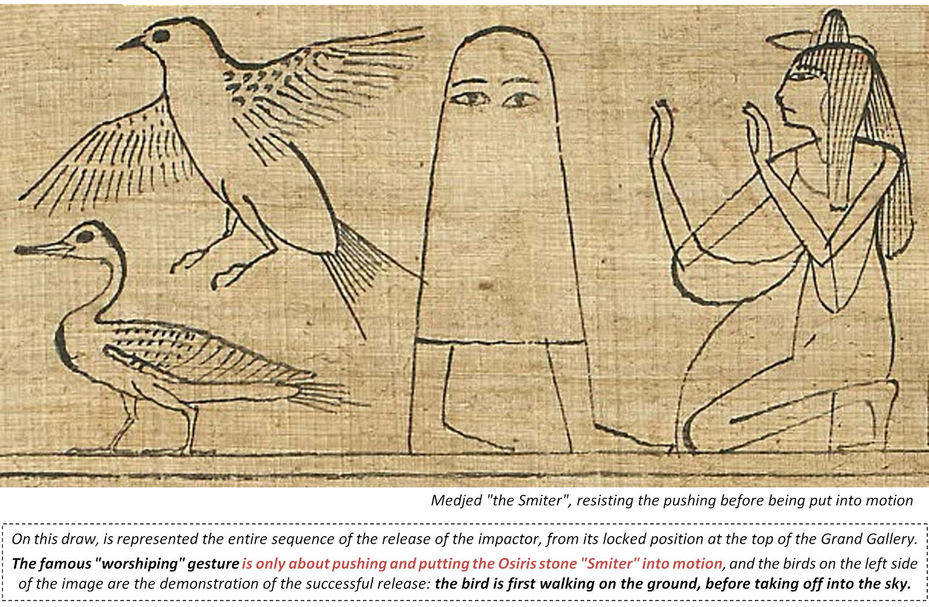
Detail of the sheet 76 of the Book of the Dead of Nestanebetisheru, known as the "Greenfield Papyrus": https://en.wikipedia.org/wiki/Medjed
26.07 The release of the impactor: when Horus the child is becoming Horus the elder
On this draw, is represented the entire sequence of the release of the impactor, from its locked position at the top of the Grand Gallery. The famous "worshiping" gesture is only about pushing and putting the Osiris stone "Smiter" into motion, and the birds on the left side of the image are the demonstration of the successful release: the bird is first walking on the ground, before taking off into the sky.
In other words, the scene is describing the moment where Horus the child becomes Horus the elder: when the impactor is gaining speed and energy into the slope of the Grand Gallery.
26.08 The representation of Medjed, first resisting the push
The scene is particularly interesting, because it first shows Medjed resisting the push: his feet are in opposition with the direction of the push; but when the bird is taking off, the bird goes in the same direction than the push.

Relief in the tomb of Paschedu, Deir el-Medina, Egypt, Luxor West-Bank, photographed by kairoinfo4u: https://www.flickr.com/photos/manna4u/430887106/in/album-72157600016963557/
26.09 The House of Osiris is actually represented right under our eyes, on the throne of Osiris itself
On this relief, nothing about Osiris is static: everything is in motion. In Section 1, it is explained that the character on the left is pushing and putting the Osiris stone into motion: the part of the throne of Osiris, without any decoration, is mimicking the hollowed cavity of the Osiris stone (mark 3 is the "House of Osiris"). In Section 2, Osiris is depicted descending down the steep slope of the hill (which is the Grand Gallery) on his throne (which is actually his own "House"), and smiting into the waters of the well, also represented at his feet.
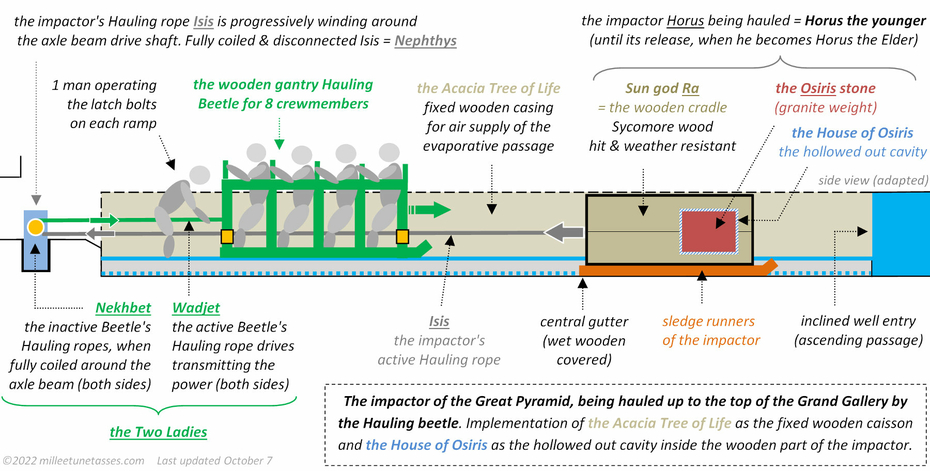
26.10 The Hauling of the impactor of the Great Pyramid of Egypt (Horus the child, also Horus the younger)
Implementation of the Acacia Tree of Life as the fixed central wooden caisson of the Grand Gallery, and the House of Osiris as the hollowed out cavity where was nested the Osiris stone, inside the wooden cradle part of the impactor.

Thutmose III (as a child) suckled by his mother Isis (also "Iset"), who "is represented into a Sycomore Tree".
and https://commons.wikimedia.org/wiki/File:Thutmose_III_and_family.jpg
26.11 Isis isn't the goddess of "the Tree", nor she is represented "onto" a Tree: Isis is the goddess "inside" the Tree
Goddess Isis, either represented into an Acacia-Sycomore Tree or as the Tree herself, is the glorification of the impactor's Hauling rope which was endlessly moving inside the fixed wooden caisson of the Grand Gallery.
Isis is represented inside the Tree because as the Hauling rope, she was inside the wooden caisson.
When just the Tree is depicted, it is because just like Medjed "the Smiter" who can't be seen because he was the impactor hidden inside the fixed caisson, Isis was also hidden and invisible inside the caisson.
26.12 Wadjet and Nekhbet weren't hidden in the fixed caisson
It is worth noting, that contrary to the central Isis rope, the two lateral ropes which transmitted the power of the Hauling beetle to the axle beam drive shaft were not inside the caisson: these ropes were always visible, on both ramps of the Gallery.
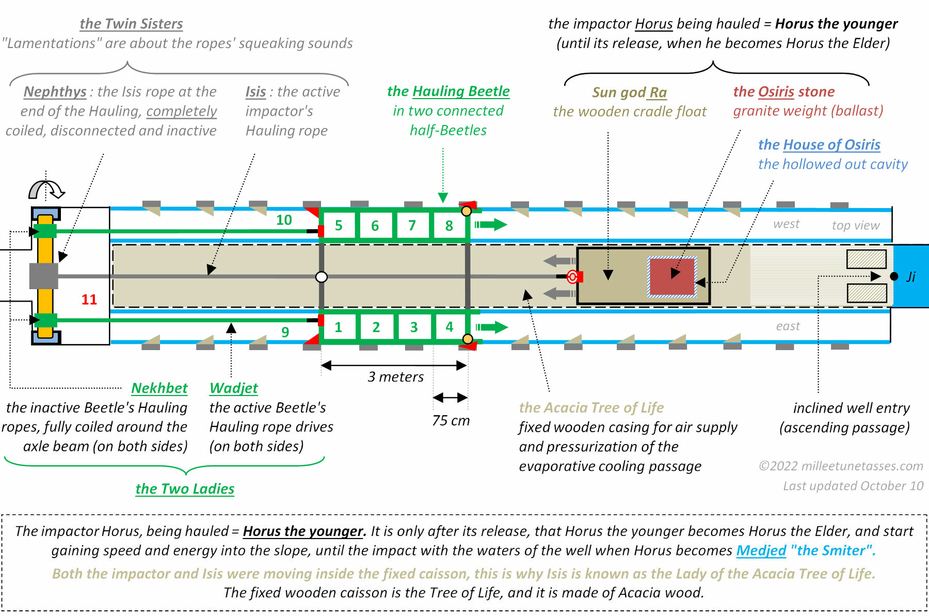
26.13 The Hauling of the impactor (Horus the child, also Horus the younger)
It is only after the release of the impactor, that Horus the younger becomes Horus the Elder, and start gaining speed and energy into the slope, until the impact with the waters of the well when Horus becomes Medjed "the Smiter". Both the impactor and Isis were moving inside the fixed caisson, this is why Isis is known as the Lady of the Acacia Tree of Life: the fixed wooden caisson is the Tree of Life.
26.14 Isis and Nephthys were together called the Two Acacia Shonti Goddesses
"While the acacia is associated with a number of Egyptian Deities, it has specific associations with Isis and Her family. A particular acacia—simply called The Acacia, or Shondj—was sacred to Her. The Goddess Shontet, the Acacia Goddess Who took part in the Osirian resurrection rites at Djedu (Mendes), was considered to be a form of Isis. And Isis and Nephthys together were called the Two Shonti Goddesses, that is, the Two Acacia Goddesses." https://isiopolis.com/2015/07/12/isis-the-acacia-goddess/
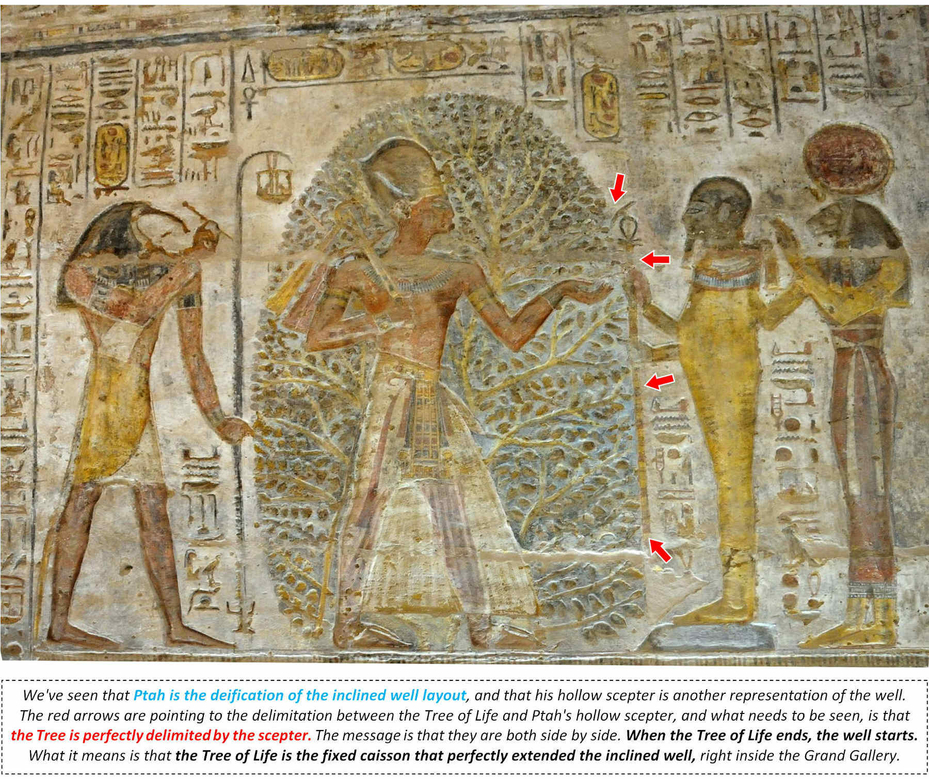
Relief of Ramesses II represented into the Ished Tree of Life in the temple of Derr, Amada. Rock temple of the 19th Dynasty, Lake Nasser in April 2008 (edited image). Original photograph thanks to Rivertay07 on flickr: https://www.flickr.com/photos/rivertay/2493217074/in/set-72157604899322576/
26.15 The Tree of Life is the wooden fixed caisson of the Grand Gallery
We've seen that Ptah is the deification of the inclined well layout, and that his hollow scepter is another representation of the well (Section 23).
The red arrows on the above image are pointing to the delimitation between the Tree of Life and Ptah's hollow scepter, and what needs to be seen, is that the Tree of Life is perfectly delimited by the scepter.
The message is that they are both side by side: when the Tree of Life ends, the well starts. What it means is that the Tree of Life is the fixed caisson that perfectly extended the inclined well, right inside the Grand Gallery.
26.16 Ramesses II after successfully having done his job in the Grand Gallery is "passing on the baton" to Ptah
One way of deciphering the above scene between Ramesses II and Ptah, would be to use the "passing on the baton " metaphor, because this is exactly what is happening. Ramesses II is proclaiming that the job that needed to be done inside the Tree of Life wooden caisson was successful: the impactor and its Osiris stone had been hauled to the top of the Grand Gallery and released into the slope; now it is Ptah's responsibility to do his own job by letting the pressurized air pass through him and produce the pressurized water at the moment of the impact with his waters.
By being represented inside the Tree of Life, Ramesses II is identifying himself with all the gods who were involved in the representation of the impactor and its operation.
In other words, Ramesses II is identifying himself with the operating cycle of the impactor inside the central caisson.
26.17 Isis, Horus and Osiris all together in the Acacia tree... as well as Ramesses II
"In the story of the “Contendings of Horus and Set,” Isis, in the form of Her sacred bird, flies into the branches of Her holy acacia after tricking Set into condemning His own attempts to usurp the rightful rule of Horus, Isis’ son. In some tales, the acacia is the tree that magically grew up around the body of Osiris when His sarcophagus washed up on the shores of Byblos. He is called “the One in the Tree” and “the Solitary One in the Acacia.” In the Pyramid Texts, Horus, “comes forth from the acacia tree.” https://isiopolis.com/2015/07/12/isis-the-acacia-goddess/
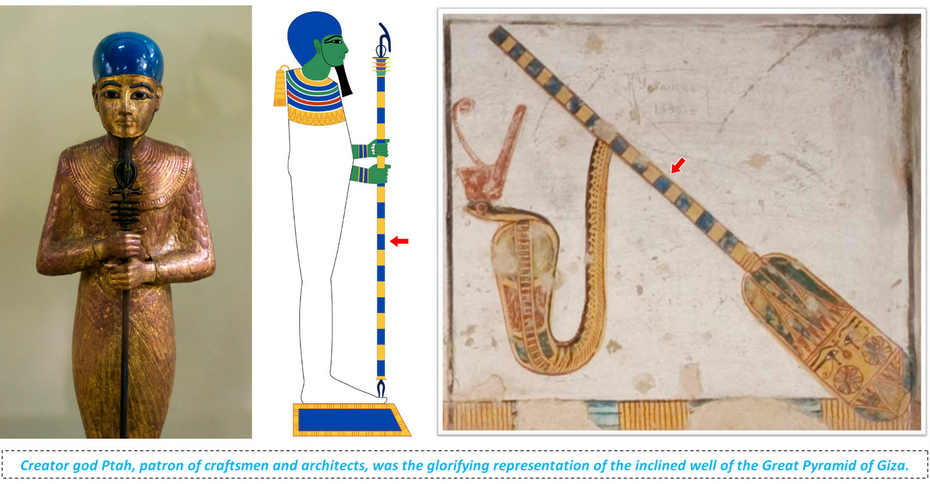
Statue of god Ptah, photographed by kairoinfo4u: https://www.flickr.com/photos/manna4u/26774477850/in/photostream/
"Ptah, in the form of a mummified man (except for arms and face) standing on the symbol for Ma'at, holding a scepter or staff that bears the combined ankh-djed-was symbols" and drawing of the Creation god Ptah by Jeff Dahl on Wikipedia: https://en.wikipedia.org/wiki/Ptah
Photograph from tomb KV 11 of Ramesses III, side chamber, image # 21076 by Matjaz Kacicnik, courtesy of ARCE, American Research Center in Egypt in partnership with the American University in Cairo Egyptology Department: https://thebanmappingproject.com/images/21076jpg
26.18 Ptah's hollow scepter is a representation of the inclined well itself
In the above image and in most of his representations, Ptah is holding a blue and yellow scepter or staff that bears the combined ankh, djed and was symbols.
This blue and yellow 'staff' is actually the representation of the inclined well of the pyramid, and the reason why the ankh, djed and was symbols seem to be nested into that 'staff' is only to indicate that it is hollow : the 'staff' is the inclined well and the dotted blue line is about the movement of water .
The representation of the well held by Ptah is always in a perfect vertical position, but its true nature is shown in the tomb of Ramesses III : it has pretty much the same slope than the Grand Gallery/ascending passage layout.
More on the ancient Egyptian god of Creation Ptah, in previous Section 21 (Tibetan Prayer Wheels) and Section 22 (Thor and Norse mythology)
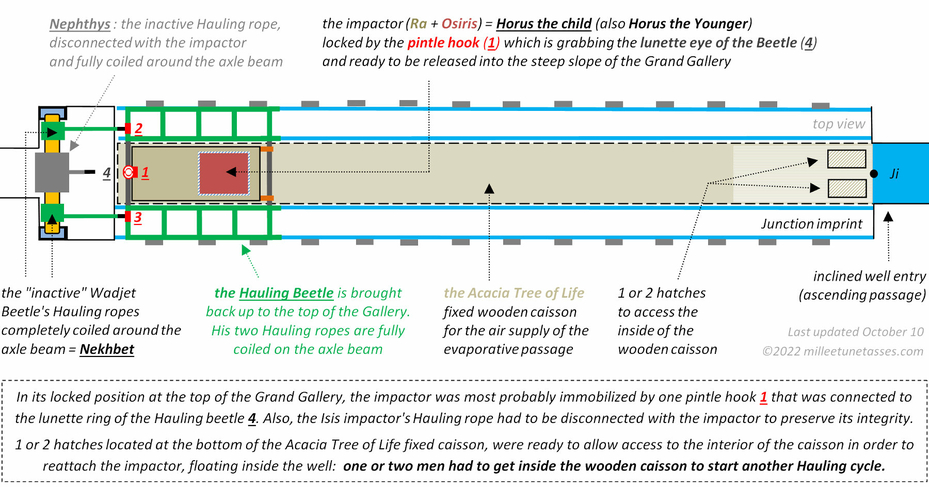
26.19 The impactor (still "Horus the child") ready to be released into the slope of the Grand Gallery
For the recovery of the impactor, one or two men had to get inside the fixed caisson to reattach the Isis Hauling rope, and start a whole new Hauling cycle towards the upper part of the Grand Gallery. The caisson had to have at least one hatch at the bottom of the Gallery.
26.20 The crucial role of the central fixed caisson for fresh air supply of the evaporative cooling passage
It is important to keep in mind that without the fixed caisson, the evaporative cooling couldn't have worked: you need both softened water with microbial stability and fresh renewed air to get the humidity out of the system in between two cycles. Without the central fixed caisson, there wouldn't be any fresh air supply possible.
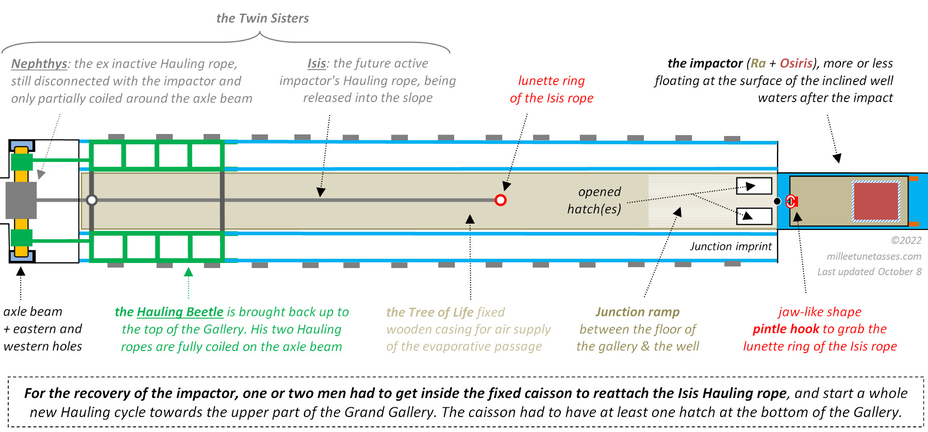
The pintle hook hypothesis would perfectly explain the "opening of the mouth" ritual.
26.21 The cry for help for the release of the Isis rope and the recovery of the impactor (Horus the child)
The following excerpt is fantastic, really, because it is talking about the exact moment when the impactor had done its job and is now floating (more or less) on the surface of the inclined well waters.
Because before being released into the slope, the impactor had to be disconnected with the Isis Hauling rope to preserve its structural integrity and reduce at the maximum its length, once inside the well, someone had to open a hatch at the very bottom of the Tree of Life fixed caisson, and reattach the Isis rope which had at this point been gently sliding down inside the empty caisson.
Listen to this, it is beautiful: the "doorkeepers at the Temple of the Holy Acacia Tree" are the crewmembers standing at the bottom of the Grand Gallery, next to the caisson; maybe two of them needed to get inside the caisson and had to open one or two hatches when they heard the impactor popping up at the surface of the well, that is them "hearing Horus crying in pain"; then they shout in the Grand Gallery so that probably the team leader of the crew can release the Isis rope inside the caisson (that is the "send a cry to the heavens for help")… because Isis (the Hauling rope) is at the other end of the Gallery, away from its impactor. Beautiful!
"In one of the poison-curing spells that include the legend of “Isis & the Seven Scorpions,” when Horus is stung and cries out in pain, it is the doorkeepers at the Temple of the Holy Acacia Tree who hear Him and send a cry to the heavens for help, since Isis is away making libations for Osiris." https://isiopolis.com/2015/07/12/isis-the-acacia-goddess/

Photograph from the tomb of Pashedu, thanks to kairoinfo4u: https://www.flickr.com/photos/manna4u/11402798564/in/photostream/
The coffer of the Great Pyramid of Khufu : "Great Pyramid Passages" Volume 1, Plate CXXV page 250, by John and Morton Edgar in 1910 : https://archive.org/details/GreatPyramidPassagesVol11910Edition/page/n259/mode/1up
26.22 The Palm Tree is another kind of "Tree of Life", one which is giving "drinking" water out of the earth
There is no direct link between the central fixed wooden caisson "Tree of Life" of the Grand Gallery which was supplying fresh new air to the evaporative cooling passage and the palm trees, but I guess this Section could be seen as the "Tree Section", so to speak.
26.23 The "drinking water" or "kissing the earth" interpretations are both correct: they are about earth filtration
The famous scene showing Irynefer "drinking from a pool of cool and fresh water", or Pashedu "kissing the earth" are actually both about the sarcophagus of the Great Pyramid, his broken piece at a corner, and of course its function in the Pyramid, that is indicated by the palm tree.
The palm tree is giving us the solution to understand the "drinking scene": the tree isn't in front or behind Irynefer or Pashedu, nor it is below or on top of "the pool of drinking water". The palm tree "is" the pool of water.
To be exact, the palm tree is a metaphor of how was produced the cool and fresh drinking water that looks like getting out of the earth itself: it is about the slow process of getting drinking water out of a palm tree…or out of a biosand "earth" filter.
We've already seen in Section 18 that the Sarcophagus of the Great Pyramid of Khufu, was precisely a biosand filter, and this is why these two scenes are represented here in the tombs of Irynefer and Pashedu: they both are glorifying representations of the crucial role of the Sarcophagus in the operation of the Great Pyramid.
On the Irynefer scene, we can even see that the artist had implemented the broken piece of the filter, on what looks like the "left side" of the filter.
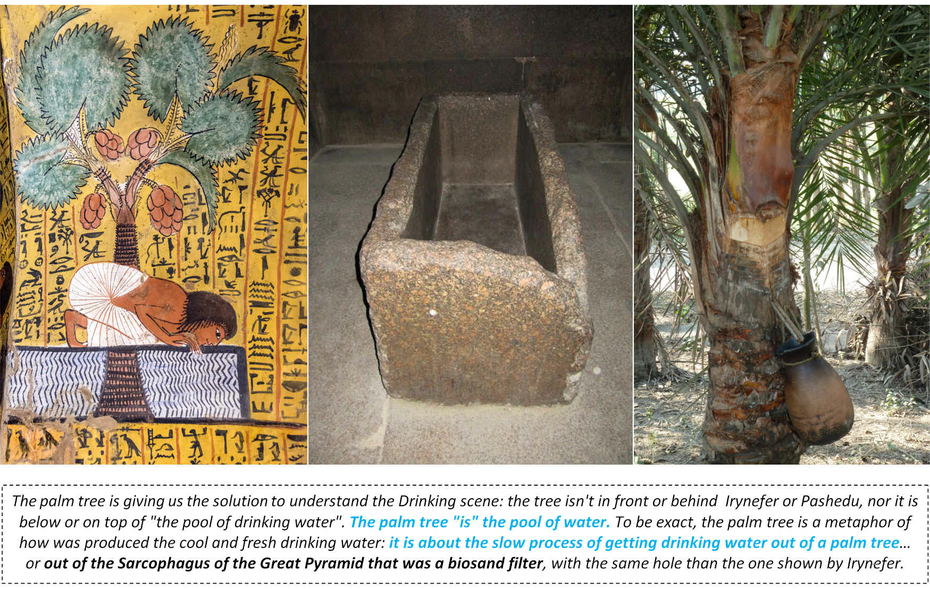
Photograph from the tomb of Irynefer, thanks to kairoinfo4u: https://www.flickr.com/photos/manna4u/11433332256/in/photostream/
26.24 The drinking water produced by the Sarcophagus was not to be drunk: it was water treatment
The catch is that the sarcophagus was producing drinking water, but it was not to be consumed, there is another metaphor here.
There are actually to main reasons why there had to be a biosand filter in the Great Pyramid, and both are about the evaporative process; because if you use untreated water for the process, there is gonna be two problems: first there will be microorganism proliferation, and second there will be very important salt deposits.
The biosand filter that was the sarcophagus took care of both problems in one single step: the microorganism layer at the surface of the filter sterilized the water and the slow sand filtration got the minerals susceptible to deposit, away.
Irynefer and Pashedu are simply demonstrating that they could drink the water "right from the earth", because the water was actually coming from the earth.
I've been using the term "biosand filter" for some time now (please read Section 18 about the Sarcophagus), but there is actually another term used for the process, and it is simply "earth filtration for drinking water".
In short, about these two scenes showing Irynefer and Pashedu, some people are explaining that they are either "drinking water" or "kissing the earth"; it turns out they are doing both things at the same time, because they are drinking water literally out of the earth due to the slow biosand filtration process of the sarcophagus
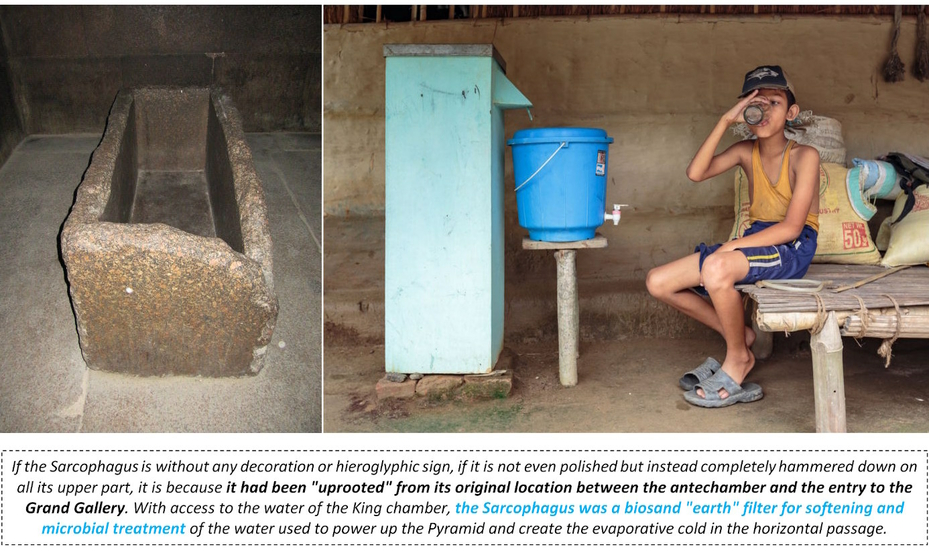
The sarcophagus of the Great Pyramid of Giza, was a biosand filter originally operated in the little room located between the antechamber and the entry to the Grand Gallery. The water treatment by biosand filtration was to control scale, corrosion, and microbiological growth within the evaporative cooling process.
"Ram Pokherai drinks clean water from his family's biosand filter. Clean water helps children stay healthy, which means they are less likely to need time away from school, so their education improves. Providing clean water has important knock-on effects." Courtesy of Editorial, Humanitarian & Travel Photographer Gavin Gough : https://www.gavingough.com/clean-water-in-rural-nepal
Images from this assignment are being used to raise awareness of the important work that Centre for Affordable Water and Sanitation Technology, CAWST is doing, providing the resources and education required for reliable clean water supplies in rural areas. https://www.cawst.org/
26.25 The sarcophagus produced about 201.96 liters of filtered water every 15 minutes
I've suggested the hypothesis that every 15 minutes or so, it was about 200 liters of water that would have been ejected from the inclined well towards the evaporative cooling passage. It just sounded right, but I didn't check one thing: was the biosand filter sarcophagus able to supply that amount of water?
I'm not an engineer, so this whole "practical" thing about numbers is clearly not my cup of tea, even if it was both crucial for the operation of the Great Pyramid and very easy basic science:
With an internal surface area of 1.98 m x 0.68 m = 1.3464 m², and a theoretical flow rate of 600 liters/hour/square meter (according to ACF data, below), the biosand filter of the Great Pyramid of Giza would have been able to supply 807.84 liters of filtered water every hour.
That is 201.96 liters of softened and microbiologically stable water every 15 minutes.
"The internal dimensions [of Khufu's Sarcophagus] are roughly 198 cm (6.50 ft) by 68 cm (2.23 feet), the external 228 cm (7.48 ft) by 98 cm (3.22 ft), with a height of 105 cm (3.44 ft)." https://en.wikipedia.org/wiki/Great_Pyramid_of_Giza
"The biosand filter has been designed to allow for a filter loading rate (flow rate per square meter of filter area) which has proven to be effective in laboratory and field tests. This filter loading rate has been determined to be not more than 600 liters/hour/square meter." From ACF: https://www.actionagainsthunger.org/sites/default/files/publications/Biosand_and_ceramic_filters_training_manual_02.2010.pdf
"ACF is a Non-Governmental Organisation (NGO). It can also be called Action Contre la Faim (ACF) which is a French phrase meaning Action Against Hunger. ACF began in France in 1979 and currently, it operates in 40 countries world wide."
26.26 No night shift for the cold production
Also from ACF, we learn that the filter had to have a pause period, up to 12 hours, every day. It means that the sarcophagus, and the entire cooling process couldn't have been in operation during this period.
Of course, this resting period occurred at night and the cold production only could have happened during the day.
"The biosand filter is most effective and efficient when operated intermittently and consistently. A recommended pause period is 6 to 12 hours with a minimum of 1 hour and a maximum of 48 hours. The pause period is important because it allows time for the microorganisms in the biolayer to consume the pathogens in the water. As the pathogens are consumed, the flow rate through the filter may be restored. If the pause period is extended for too long, the microorganisms will eventually consume all of the nutrients and pathogens and then eventually die off. This will reduce the removal efficiency of the filter when it is used again."
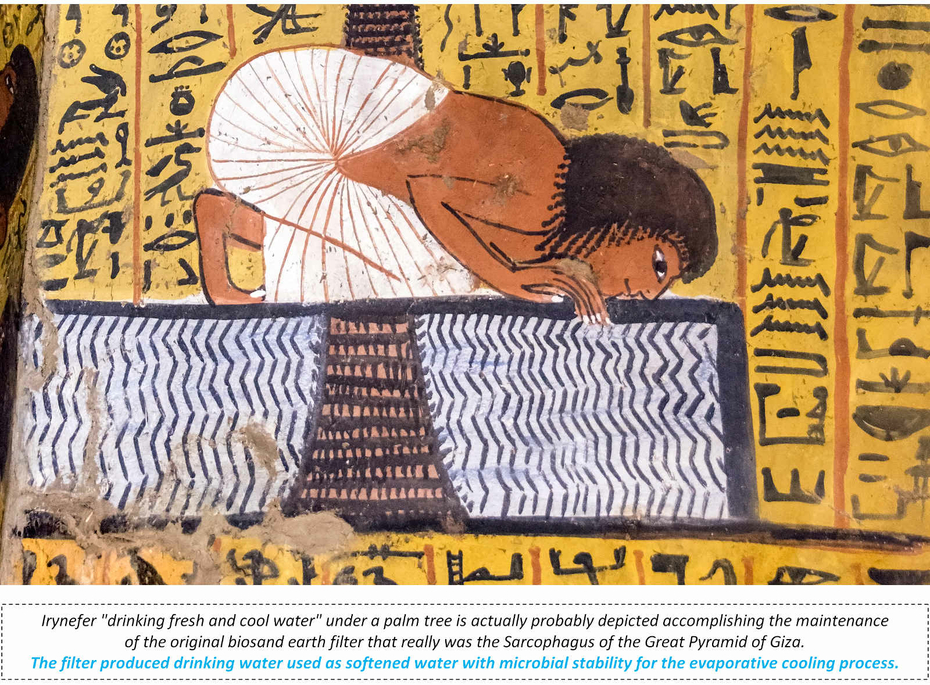
Irynefer "drinking fresh and cool water" under a palm tree is actually probably depicted accomplishing the maintenance of the original biosand earth filter that really was the Sarcophagus of the Great Pyramid of Giza. The filter produced drinking water used as softened water with microbial stability for the evaporative cooling process.
26.27 Irynefer's inverted right hand indicates a movement of the hand from left to right
There is also something weird about Irynefer's right hand: the thumb of this hand is clearly the thumb of the left hand. Irynefer's right arm is actually supporting his left hand, and in my opinion it is a way of indicating the movement of the hand, from left to right.
The scene is not static: Irynefer is bent over the filter, and he is agitating his hand in the water at the surface.
26.28 The best biosand filter maintenance method is the Surface Agitation method
The idea that Irynefer and Pashedu are both represented servicing a biosand filter is precisely this "weird" left hand on the right arm, that indicates the movement of the hand; the exact movement that needs to be done with the hand when using the Surface Agitation method for realizing the maintenance of such Biosand filters.
"Over time, the pore opening between the sand grains will become clogged with sediment. As a result, the water flow rate through the filter will slow down. To clean the filter, the surface of the sand must be agitated to resuspend the sediment in the standing water. The dirty water can be removed using a small container. The process can be repeated as many times as necessary to regain the desired flow rate. After cleaning, it will take the biolayer up to a week to reestablish itself and return the removal efficiency to its previous level." https://www.actionagainsthunger.org/sites/default/files/publications/Biosand_and_ceramic_filters_training_manual_02.2010.pdf
"The authors recommend using the surface agitation method for filter maintenance, as this method was associated with higher removal rates of thermotolerant coliforms and turbidity [in the filtered water]." https://www.purewaterfortheworld.org/wp-content/uploads/2015/10/Singer-et-al-2017-BSFSurfaceMaintenance.pdf
26.29 Were Irynefer and Pashedu involved in the operation and/or the research on biosand earth filters?
Because both Irynefer and Pashedu were foremen, and probably with a very high position among craftsmen, because of the magnificence of their tombs, I would tend to say that in the "drinking water" and "kissing the earth scene", they are actually both represented accomplishing the maintenance of a biosand filter.
Maybe they are even depicted on the original biosand earth filter that was the Sarcophagus of the Great Pyramid of Giza, even if they never were directly involved in this particular filter. It would be like an honorary distinction.
Even if I disagree with the conclusion of the study from which the following excerpts are coming from, I strongly recommend you have a look at it, because there is a lot of very good material in it. The study is "Kissing the earth’ scene in Pashedu Tomb", by Doha M Sami Abdel Hamid (Journal of Association of Arab Universities for Tourism and Hospitality), and is actually about both the Irynefer and Pashedu scenes: https://jaauth.journals.ekb.eg/article_53832_f93c00895e949195df9292d38c5b775f.pdf
"Pashedu was a foreman at the beginning of the 19th Dynasty. He had the titles: “Servant in the Place of Truth on the west of Thebes”, “Scribe in the place of truth”.
"The community at Deir el-Medina consisted of the workers and craftsmen who were employed in the construction of the New Kingdom royal tombs, Maspero suggests that the workers of Deir el-Medina were a kind of religious community who maintained the cults of kings who were buried at Thebes. Royal tomb artisans throughout the Egyptian new Kingdom considered Deir el- Medina as their eternal home."
“Kissing the earth scene” in Pashedu tomb was probably represented in order to show a kind of pray or an act of obeisance or adoration, accompanied by spell of chapter 62 of the book of the dead “chapter for drinking the water in the Necropolis”. In spite of the presence of chapter 62, Pashedu was not probably kneeling in purpose of drinking because it's not familiar to drink in a such way, but he was kneeling in order to kiss the holy earth of the underworld or kissing the water of the underworld , that's why the scene was decorated and accompanied by the chapter 62, chapter of drinking water."
"Irynefer beard the title: "servant in the place of truth" during Ramses II's reign. His tomb is one of the better preserved tombs of Deir El Medina, and one of the most colorful of the tombs of the craftsmen. The scene is very similar to Pashedu's scene, this scene is located at the top of the eastern wall near to the entrance, where Irynefer is kneeling before a Dome-palm tree, or a palm-tree according to Porter and Moss, drinking from a pool of fresh water, spell for "drinking water in the necropolis", from chapter 62 of the Book of the Dead."
"Deir El-Medina tombs were characterized by this kneeling down under a dom-palm tree scenes, which were not represented in Valley of the Kings scenes. Although spells from the book of the dead were represented on walls of valley of the Kings tombs, the scene of “kissing the earth” or “drinking water” was not seen on Kings private tombs."
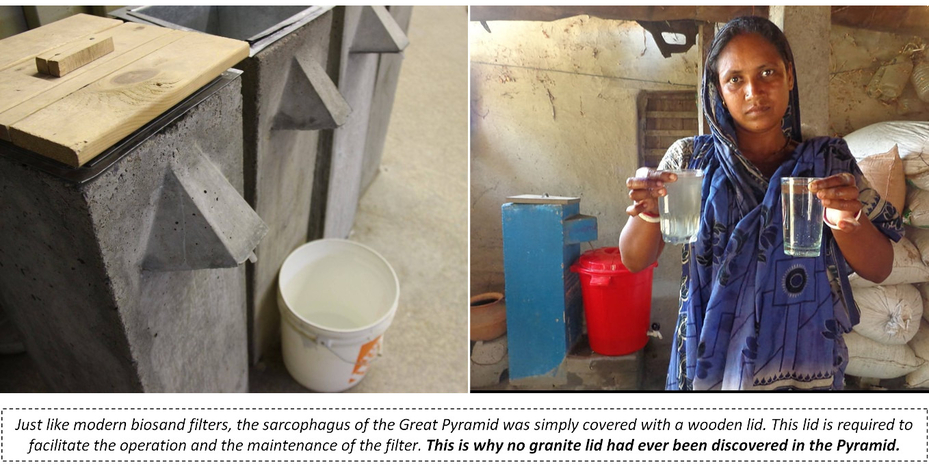
Photographs from : https://wiki.lowtechlab.org/wiki/Water_-_Biosand_Filter#
26.30 The up to one-half inch thick salt incrustation in the Queen's chamber & Horizontal passage
Despite the softening treatment realized by the biosand filter Sarcophagus, and just like nowadays, the evaporative cooling process produced limescale: salt encrustation.
The salt encrustation inside the Great Pyramid has been mainly documented in the Queen's chamber, where it could have been up to one-half-inch thick in some places, 1.3 centimeter, and in the horizontal passage, but also in a smaller extent in the lower part of the Grand Gallery and in the ascending passage.
It is crucial to note that there was absolutely no salt encrustation documented anywhere else in the Great Pyramid: its distribution is perfectly explained by the evaporative process and the particular layout of the junction between the Grand Gallery, the ascending and horizontal passages.
The following excerpt is from "Great Pyramid Passages Vol 1, 1910 edition" by John and Morton Edgar, paragraph ref. 584, page 293 : https://archive.org/details/GreatPyramidPassagesVol11910Edition/page/n301/mode/2up
Paragraph. ref. 584 : "Following these uniform sets of 15 stones, are two long stones in each course, averaging about six feet in length, after which each wall is built in one course only, apparently as far at least as the drop in the floor of the passage ; but beyond this, on to the Queen's Chamber, the very thick and hard incrustation of salt which entirely covers the walls of this passage, made it impossible for us to locate the joints with any certainty. This salt incrustation is peculiar to the Horizontal Passage and Queen's Chamber, although a little of it may also be seen on the walls of the First* Ascending Passage."
* For some authors, the first ascending passage starts at the granite plugs and ends with the start of the Grand Gallery, the second ascending passage.
Excerpt from "The pyramids and temples of Gizeh" by Petrie, W. M. Flinders (William Matthew Flinders), Sir, 1853-1942 : "The size of the chamber (after allowing suitably in each part for the incrustation of salt) is on an average 205 85 wide, and 226*47 long, 184*47 high on N. and S. walls, and 245*1 high to the top of the roof ridge on E. and W. walls." https://archive.org/details/cu31924012038927/page/n103/mode/2up
26.31 Salt encrustation is the signature of the evaporative cooling process... even nowadays
Of course, the salt encrustation in evaporative cooling systems is not about table salt NaCl, but primarily calcium carbonate CaCO3 also called calcium scale, or limescale.
With most of the pyramid built with limestone, this is not a surprise that limescale would have been a major problem.
From "Evaporative Cooler : Self Salt Clean", by Mohammed Ali Bahobail from the Department of Architecture and Building Sciences, College of Architecture and Planning, King Saud University, a Public university in Riyadh, Saudi Arabia : "Evaporative coolers are relatively economical, less expensive to install and to operate. They are consuming less electricity than a refrigerated unit, and they do not need an expert to maintain. In addition, evaporative coolers provide the building with a fresh humid air. However, evaporative coolers have some disadvantages; one of them is the deposited salt. Water usually has a high percentage of mineral. The evaporative mechanism will leave mineral deposits on the pads and interior of the cooler. This cumulative mineral will close the porous of the wetted pads and damage them and will participate to corrosion of the cooler frame."
The work made by Mohammed Ali Bahobail is about coolers designed with wetted pads where water is circulating, there is no fog of microdroplets, but the principle is the same and the deposited salt problem is the same.
https://cap.ksu.edu.sa/sites/cap.ksu.edu.sa/files/imce_images/jap_ksu_jan2013_e1_0.pdf
26.32 The 1998 salt encrustations cleaning
Unfortunately, the salt deposits have been removed since the first explorers of the pyramid reported its presence, most likely when the chamber was cleaned by Zahi Hawass in 1998 :
Zahi Hawass (Director General of the Giza Pyramids, between 1987 and 2002) : "Each visitor produces nearly an ounce of moisture with a high saline content through their breath and perspiration. This results in the accumulation of salt, which leeches into the limestone and plaster and gradually causes them to crumble into powder. So, in 1998, we spent 12 months cleaning the salt."
Excerpt from https://www.world-archaeology.com/features/pyramids-excavation-and-preservation/
Mr Hawass is obviously blaming tourists for the salt encrustations in the Queen's chamber, but when the first explorers of the pyramid discovered these encrustations, there wasn't any tourist at all visiting the pyramid. The remark of Mr Hawass, is pretty funny though : did we ever had to periodically close down limestone built churches, cathedrals or any other pyramid or building made of this material (I guess in Mr Hawass' mind, limestone is a key element of the salt deposits in the Great Pyramid), just to remove the salt? Be that as it may, salt deposits were only documented in the Grand Gallery in its lower part (most probably just around the junction with the horizontal and ascending passages); did tourists stop breathing passed this point, and did they climb the gallery and visit the King's chamber in total apnea ? Were they offered respiratory masks ?
The cleaning of the salt deposits is actually a real drama, because before 1998 it was still possible to know exactly at what temperature the Queen's chamber was cooled down, simply by analyzing the crystalline structure of the deposits, the size and shape of the crystals.
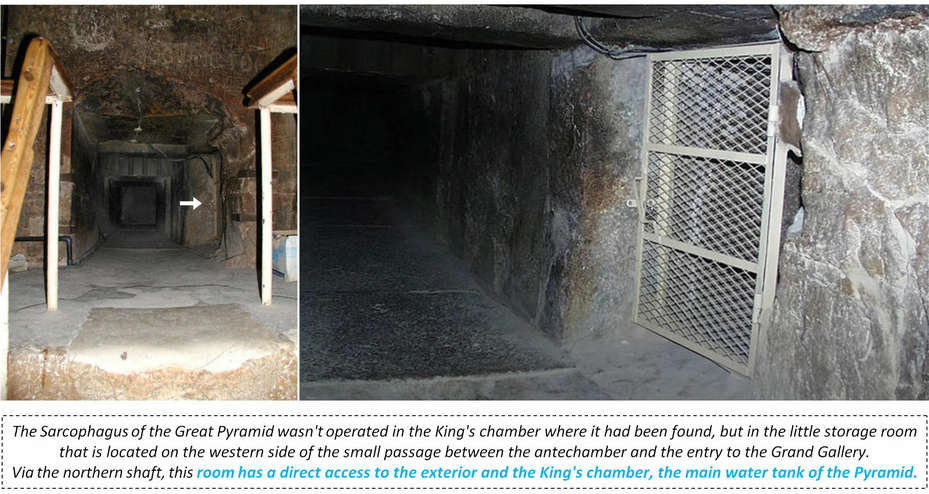
26.33 The original operating location of the Biosand filter Sarcophagus
If the Sarcophagus is without any decoration or hieroglyphic sign, if it is not even polished but instead completely hammered down on all its upper part, it is because it had been "uprooted" from its original location between the antechamber and the entry to the Grand Gallery. With access to the water of the King chamber, the Sarcophagus was a biosand "earth" filter for softening and microbial treatment of the water used to power up the Pyramid and create the evaporative cold in the horizontal passage.
More on the Sarcophagus in Section 18.
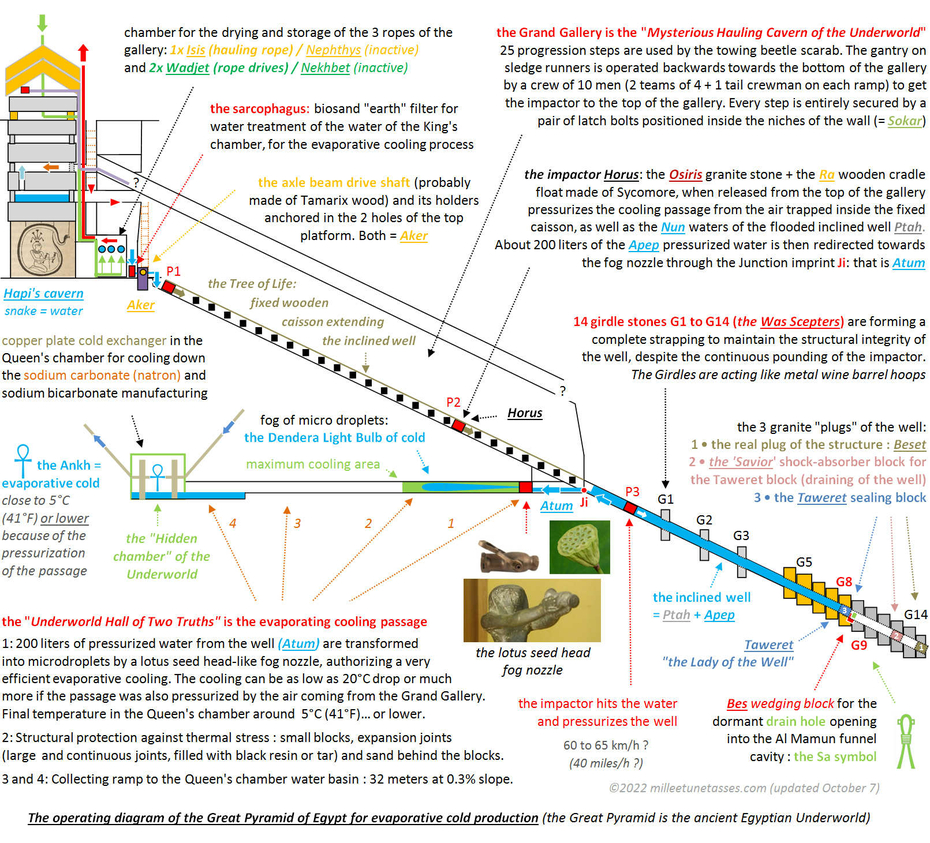
26.34 Operating diagram of the Great Pyramid of Egypt for evaporative cold production of a Solvay or Solvay-like process
The Great Pyramid has been designed for the cooling of chemical manufacturing of sodium carbonate (natron) and sodium bicarbonate. Last updated: Octobre 7, 2022.
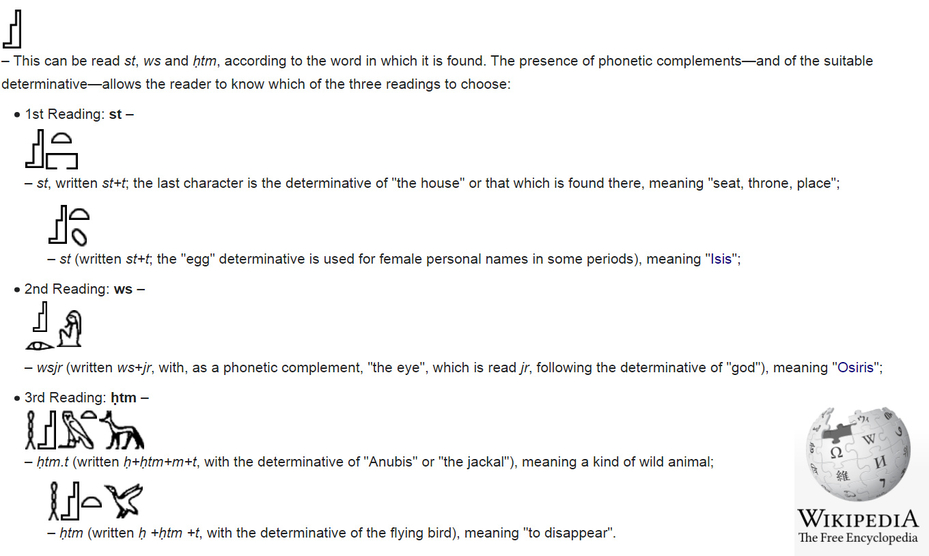
"There were about 1,000 graphemes in the Old Kingdom period, reduced to around 750 to 850 in the classical language of the Middle Kingdom, but inflated to the order of some 5,000 signs in the Ptolemaic period. Antonio Loprieno, Ancient Egyptian: A Linguistic Introduction (Cambridge: Cambridge UP, 1995)." In "Notes and references" at https://en.wikipedia.org/wiki/Egyptian_hieroglyphs
26.35 Ancient Egyptians maybe really called Medjed "the impactor"
At this point I need one more time to emphasize the fact that despite what every egyptologist is claiming, we do not understand the full meaning of every single hieroglyph; and for one particular reason: if you are wrong in the overall context of what you are trying to decipher, you will get wrong translations.
The entire process of deciphering ancient Egyptian hieroglyphs is based on the discovery of the Rosetta stone, a stele which was erected after the coronation of King Ptolemy V and was inscribed with a decree that established the divine cult of the new ruler, in three languages: the top and middle texts are in Ancient Egyptian using hieroglyphic and Demotic scripts respectively, while the bottom is in Ancient Greek. https://en.wikipedia.org/wiki/Rosetta_Stone
This gave to Champollion the opportunity to start deciphering the hieroglyphic text, but the context was political.
And the problem is that most of the important texts about ancient Egypt are directly referring to the scientific knowledge and technological accomplishments of the time; whether it occurred in temples, mastabas or great pyramids.
Ancient Egyptian temples were temples of knowledge, temples of learning and temples of experimentations.
At the time of the Old Kingdom, it was about 1000 different signs that were used, but I'm not sure it includes every variants of each sign; but I'm sure it doesn't include the color in which it had been painted, or if it was written from left to right or from right to left.
Anyway, I don't understand why 1000 different hieroglyphs were used in the Old Kingdom, and more than 5000 in the Ptolemaic period, if these signs were just about consonant syllables (as an extremely quick summary of the writing deciphering, I know). On the above screen shot from Wikipedia, it is explained that ancient Egyptians (mostly) used hieroglyphic signs to determine consonants like "st", "wsjr" or "htm"; and that each individual or combined sign just wasn't meaningful at all. At least when we are reading modern rebus, we do care for the meaning of each sign.
Maybe Medjed wasn't called the "Smiter", but really "the impactor".
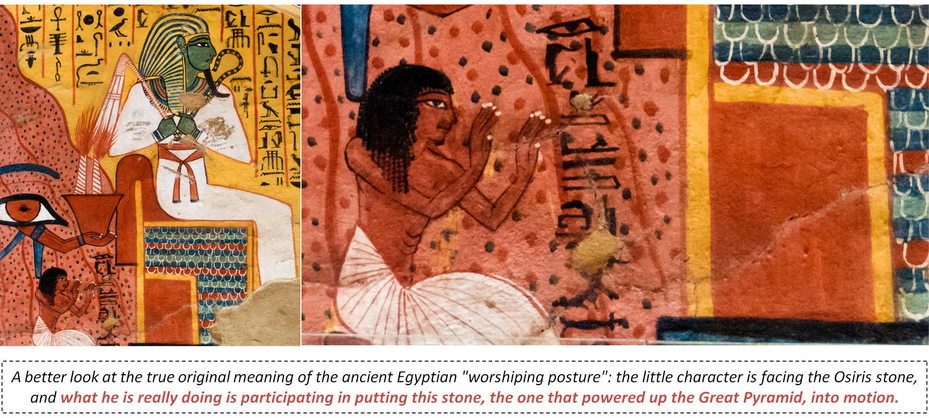
Tomb of Pashedu TT3 at Deir el-Medina, thanks to kairoinfo4u : https://www.flickr.com/photos/manna4u/11403232974/in/photostream/
26.36 The ancient Egyptian worshiping posture is about pushing and putting the Osiris stone into motion
A better look at the true original meaning of the ancient Egyptian "worshiping posture": the little character is facing the Osiris stone, and what he is really doing is participating in putting this stone, the one that powered up the Great Pyramid, into motion.
26.37 Summary of the study: hidden behind the academic vision of the ancient Egyptian religion, a vast number of metaphors are describing some of the most advanced science and technological knowledge of that time : ancient Egyptian gods were nothing else than pharaohs' metaphoric self-glorifications of their theoretical and experimental scientific accomplishments in physics and chemistry.
Pharaohs used the power of Science to legitimate themselves as kings of Egypt : they forged an entire religion, based on science to rule their kingdom, and they presented that science as Magic.
The end game of this technological program that probably started on the very first Dynasty, was the Great Pyramid of Giza where evaporative cooling was engineered in the known part of the pyramid from the pressurized water produced in the inclined well, known today as the ascending passage.
The evaporative cold simply took advantage of the power of water, and was most probably necessary to cool down chemical manufacturing of sodium carbonate and sodium bicarbonate produced by an ammonia-soda Solvay process, as suggested by the very strong ammonia smell and the limestone kiln in the so-called burial chamber of the Red Pyramid. At that time, sodium carbonate was called natron, and it was the salt used for the mummification of the pharaohs (Sections 14, 15 and 16).
The cooling seems to have represented the most difficult part of the process, as suggested by the Step Pyramid's official name : according to scholars, the very first pyramid complex, the Step Pyramid of Djoser, was called "the refreshment of the Gods". No doubt that a more accurate translation would certainly be "the cooling of the Gods".
It means that ancient Egyptians were the first civilization to master a Solvay-like process for sodium carbonate manufacturing, long before it got reinvented in the 1800's in Europe. The key elements of that process is the temperature control of the chemical reactions (the cooling), and the dome shaped plate necessary for the counterflow chemical reactions to occur in an efficient way. That counterflow reaction plate is what really is the disc of Sabu.
As shown with Akhenaten and Nefertiti, the creation of the evaporative cold was the most sacred accomplishment of all (Section 17), and this is exactly what the Dendera Light is all about : the Dendera Light is the fog of microdroplets of liquid water that evaporates and creates the cold. Talking about the snake inside the Dendera Light Bulb : "The field surrounding Ra’s snake form is referred to in ancient Egyptian literature as protective magical energy in liquid form that all gods and pharaohs possess" (Faulkner, Section 2).
Everything that had been done in the Great Pyramid of Giza inspired most of the ancient Egyptian religion, and it had been glorified into what we know today as the Underworld.
The Underworld is referring to the chambers and passages of the Great Pyramid of Khufu, and in particular to the Grand Gallery where a hauling gantry beetle operated a wooden coffin shaped impactor that had a small nested granite block inside it. The impactor generated endlessly, over and over, maybe every 15 minutes the pressurized water that was then transformed into a fog of microdroplets inside the horizontal cooling passage.
The Grand Gallery of the Great Pyramid where the act of hauling was done, is the "Secret Hauling Cavern of the Underworld" described in the Amduat "Book of the Hidden Chamber".
The most important chamber of the Great Pyramid wasn't the King's chamber that only was the main water tank of the pyramid, but the Queen's chamber, the only one on the central axis of the pyramid. Because the Queen's chamber was inaccessible from the rest of the pyramid, it was glorified into the "Hidden Chamber of the Underworld" (Section 11), and because the Queen's chamber was the coolest place in the pyramid (about 5°C / 41°F), and with a constant 100% Humidity rate, this chamber was the one where the biggest amount of very hard salt encrustation had been documented by the first explorers of the pyramid in the 1800's and before it had been removed in 1998 by Zahi Hawass (Section 1). Very hard salt encrustation is the signature of the evaporative cooling process, even nowadays.
The most incredible thing is that pretty much everything I've just said, actually appears in many myths, and they don't even originate from ancient Egypt : the "Churning of the Ocean" Hindu myth that produces the immortal nectar Amrita, the Tibetan Prayer Wheels operated to give small amounts of 'merit' to too lazy Naga snakes, and the entire Norse mythology with Thor's magical hammer endlessly fighting another Great Serpent of the Underworld and producing a mist of cold from a mysterious well that would be opposed to hellishly hot heat waves.
I'm talking a lot about the impactor of the Great Pyramid, but it is nothing compared to the tremendous impact caused by what the ancient Egyptians had accomplished within the 78 years of the Great Pyramids Era, from Djoser to the Great Pyramid: the entire ancient World had been shaken up in their deepest beliefs beyond all comprehension; and we are still talking about it today.
Poster un commentaire
